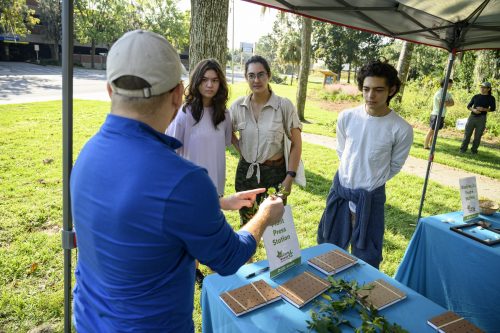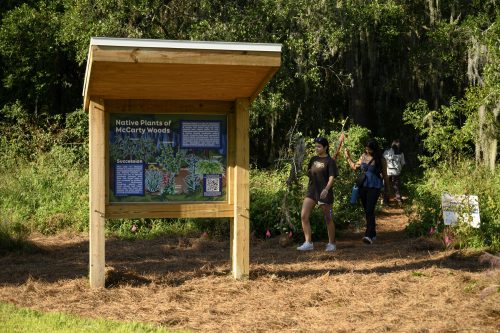At the heart of UF’s main campus, a 2.9 acre stretch of land offers a unique and educational natural space for students, staff, faculty and the public to enjoy.
It’s an incredibly diverse area inhabited by over 350 plant, fungi and animal species, including a one-flowered haw that is the National Champion or largest of its species, and the largest recorded white ash tree in Florida. These species work in harmony to create an essential ecosystem – one that reduces stormwater runoff from large storms and functions as a “living research facility” at the University of Florida.

But it wasn’t always this healthy.
This is McCarty Woods, one of the few remaining green areas on UF’s campus thanks to an initiative that started here at the Florida Museum.
After museum staff Doug and Pam Soltis, Lucas Majure and Matt Gitzendanner successfully campaigned for construction plans to cease in the iconic area, they set out on a project to clean up the upland-mixed hardwood forest and have been working ever since.
For three years, volunteers have gathered once a month to pull invasive species, water plants, pick up trash and add native plants.
“Without volunteers we would not be where we are today,” Doug Soltis said. “They have made it possible to turn things around and really get the woods in the shape it is now.”
Looking to the future, there’s still work to be done. McCarty Woods still needs a maintained trail along its north side, more picnic tables, signage on the trees and plantings.
If you’re interested in volunteering with the project, you can join the monthly restoration days by checking the McCarty Woods website for updates.
Can’t volunteer? You can also support the McCarty Woods restoration project, by donating to the Florida Museum McCarty Woods campaign, now through November 17. Proceeds go to essential parts of maintaining the forest, such as purchasing plants, repairing kiosks and additional restoration efforts.

Your gift to the campaign will also go toward the McCarty Woods Genome Sequencing project. The genomes of iconic trees in the forest are being sequenced for the first time, and to do so the McCarty Woods team needs to pay for the sequencing and train undergraduates in computational work and genomic skills.
With your support, not only can volunteers continue to revive the forest, but researchers from different skill levels can continue to use the woods as an educational hub, inspiring future campus restoration projects and helping create a greener life on campus.